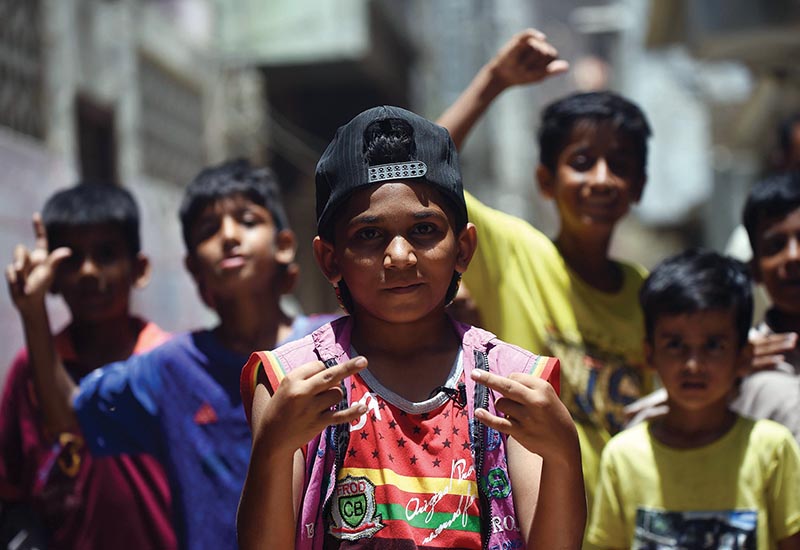

Haunted by gangviolence and poverty for decades, Lyari was once considered one of Pakistan'smost dangerous areas, but those grim realities also inspired a generation ofartists and spawned a burgeoning hip hop scene. With its close proximity to thesea and history of smuggling, the largely ethnic Balochi neighborhood inKarachi stands apart for its history of violence and lawlessness-even byPakistan's standards.
When Karachiserved as a major transport hub during the Afghan jihad against the Soviets,Lyari was hit hard by the influx of weapons and drugs-and the surge inbrutality such black market businesses bring. Heavily armed gangs and politicalhit squads exerted iron-fisted control over large swathes of Lyari, squashingeconomic growth while residents battled with the fallout, including rampantdrug abuse and poverty. "Lyari wasa notorious place because of the gangs and the war. It was almost impossiblefor outsiders to even think about entering," explains resident and newrapper Mohammad Omar.
But in recentyears, the gangs have been brought to heel following a heavy-handed operationby paramilitary forces that kicked off in 2013 and saw the streets turned intovirtual war zones. In the battle forLyari, gangs infamously used rocket propelled grenades and assault rifles tofight security forces, with the crossfire shuttering schools and businesses andalso keeping kids off the streets. "Children used to cry listening to the fierce gunfire," saysOmar, adding: "The poor people were the victims of those gang wars. Wewitnessed all those things."
'Showing reality'
But the worst ofthe violence has abated, and an increase in security has led to floweringcreativity. The embattled neighborhood now clings fiercely to its reputationfor producing top footballers, iron-chinned boxers, and most recently sociallyconscious rappers.
The rise of hiphop in Lyari mirrors the genre's own birth decades ago in New York's Bronxborough, where it largely centered around street performances and featuredlyrics that addressed social ills and life in urban ghettos. Hip hop became a global phenomenon, but thegenre initially failed to generate much traction in Pakistan where music fanstended to listen to pop, Bollywood soundtracks or traditional Sufi music. Theoccasional forays by Pakistani musicians into hip hop over the years largelyserved as interludes in pop songs that veered closer to comedy.
Not so in Lyariwhere rappers were influenced by the likes of Tupac Shakur and looked to theirown experiences for lyrical inspiration. "In other cities and provinces,there's rap but it's mostly about beautiful women and luxury cars," saysproducer Qammar Anwar Baloch. "Weare showing reality."
This artisticexpression with a bass line first burst onto the nation's airwaves in 2017following the release of the hit song and video "The Players ofLyari" by the Lyari Underground. The anthem doubles as an ode to the neighborhood's love for football incricket-obsessed Pakistan along with a fiery rant lambasting the country'ssporting authorities for neglecting the neighborhood's football talent."The young people in Lyari represent one of the first times in Pakistanihistory where kids from the working classes are contributing to the music thatupper classes listen to as well," explains writer Ahmer Naqvi. "They're using this moment to sort ofassert their own place within Pakistani society, to not be content with beingon the margins," he adds.
Digitalunderground
For years, theirvoices and stories were largely invisible in Pakistan. With little performancespace available Lyari's rappers have largely turned to the internet to sharetheir clips of their songs, which generate millions of views online. "I want to highlight the issues inKarachi and my own area in Lyari," explains eight-year-old rapper WaqasBaloch, who released a video under the moniker Thousand earlier this summer.The young MC is just one of dozens of rappers to pick up a microphone in recentyears, according to residents following the scene closely.
For cleric JameelAhmed-who runs a madrassa in Lyari-youth interest in music and personalexpression is a welcome relief after years of tough times. "It is far better than drugs, boozeand other such menaces. Music is helping them stay away from such things,"says Ahmed. He adds: "Now, theirminds are opening up."-AFP

